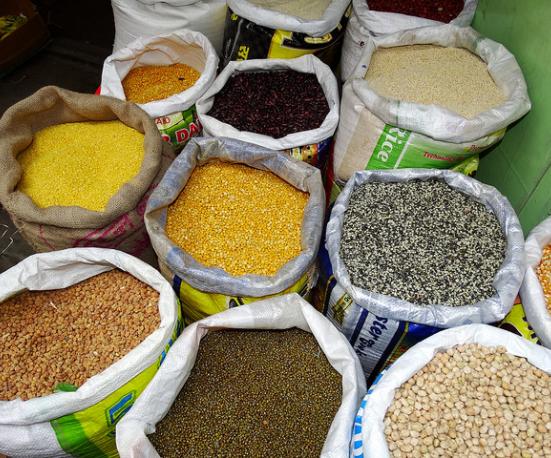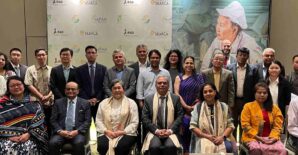Cross-posted from the FSP India website written by Bas Paris

Pulses; Credit: Adam Jones (Flickr)
Pulses are an essential source of protein and minerals for much of the Indian and global populations, to reflect this the UN has named 2016 as the ‘’International Year of Pulses.’ A recent IFPRI discussion paper investigates the trends and outlook for both global and regional pulse economies, looking at the supply, demand, trade, prices, and outlook of the pulse sector during the last three decades. The study covers the main pulse producing regions, namely: Europe, North America, Oceania, Africa, Latin America, and Asia using data from the FAOSTAT database complemented by national-level data. The report also provides an in-depth analysis of a selected group of pulse crops including chickpea, lentils, pigeon pea, dry beans, and dry peas.
The average share of pulses in global diets is only 5 percent of total protein consumption, but pulses’ contribution to diets at the country level is significantly higher. In the case of India, 12.7 percent of proteins in people’s diets come from pulses. Moreover, pulses contain other essential nutrients such as calcium, iron, and lysine that help the body fight vitamin and mineral deficiencies and disease. Thus, pulses can be important in fighting malnutrition. Pulses also contribute to soil fertility due to their nitrogen-fixing ability, which helps reduce the need for chemical fertilizers for crops planted on the same land.
The report provides an overview of changes over the past three decades in total pulse production, area under cultivation, and yields per hectare. Globally, pulse production increased from 44.9 million tons in 1981-1983 to 72.3 million tons in 2011-2013. The area under production increased from 63 million hectares to 80 million hectares over the same time period.
At the country level, India is the world’s largest pulse producer, accounting for 34 percent of area and 24 percent of production in pulses. Production in India increased from 10.4 million tonnes to 17.5 million tonnes from 1981-1983 to 2011-2013, mainly due to increases in the area under production from 22 million hectares to 27 million hectares. However, as population growth has grown faster than growth in pulses, the per capita availability has decreased. In 2013, India’s average yield per hectare also remained low, at 635 kilograms per hectare. One reason that yields remain low in India is because pulses are generally grown on marginal land with little access to irrigation. In total, it is estimated that only 10 to 15 percent of pulses cultivated in India have access to irrigation, while the figure is around 75 to 80 percent for wheat and rice. By comparison, Myanmar’s and Ethiopia’s yield per hectare averages 1345 and 1442 kilograms while Canada achieves the highest global yields at 2146 kilograms per hectare.
Regarding specific crops, India is the world’s largest producer for multiple pulse crops, including chickpeas (67 percent of global production), pigeon pea (63 percent of global production), and dry beans (33 percent of global production). India is also the world’s second largest producer of lentils (22 percent of global production). Simultaneously, India has a high ratio (83.6 percent) of pulses that are used for domestic consumption. Additional information on pulse developments in India is available here.
The study also analyses the global and regional pulse trade. International trade in pulses has grown significantly, from around 2 million tons of pulses in the 1970s to 12 million tons in 2011. Developed countries are the main exporters, exporting around 52 percent of production. India, by contrast, only exports 167,000 tons due to high levels of domestic consumption (but exports have grown from 1,000 tons in 1981). India is by far the biggest importer, at 3 million tons annually, up from 127,000 tons in 1981.
Global pulse prices stagnated in the 1980s and 1990s but started rising again in 2000 and rose sharply in 2006. Pulse prices are currently around 2 to 2.5 times higher than cereal prices globally. Given these price changes and the shifts in supply, it is important to better understand these trends and how they may play out in the near future.
The authors make numerous projections regarding future pulse supply and demand using the IMPACT model (International Model for Policy Analysis of Agricultural Commodities and Trade). Supply and demand projections for total pulses were carried out under a business-as-usual scenario in area and yield growth and these projections were carried out to 2020, 2030, and 2050 for the major pulse-growing regions.
The results indicate that Africa and Asia will face large deficits in pulse supply - close to 11 million tons in Africa in 2050 and 5.5 million tons in Asia. These findings can vary within regions, however. For example, within Asia, Eastern Asia will see a surplus, while Southern Asia will see a deficit of 9 million tons by 2050.
The paper suggests that the relatively faster increase in the food demand for pulses in Africa and Asia (Southern Asia in particular) could be attributed to faster-paced increases in their populations compared with other regions. Between 2020 and 2050, Southern Asia’s population is expected to expand by 27 percent. In addition to a growing population, other drivers of pulse demand could include the importance of pulses as a protein source for vegetarian populations, income growth for low-to-medium-income consumers, growth in urban populations and increased demand for processed pulse products, and the realization of the health benefits of pulses. Ananalysis by Kumar, Joshi, and Birthal projects that demand for pulse crops in Southern Asia (comprising India, Pakistan, Bangladesh, Nepal, Sri Lanka, and Bangladesh) will increase from 17.6 million tons in 2005 to 24 million tons by 2025. That rate of growth in demand for pulses is more than the rate projected for any cereal crop (including rice and wheat).
Supply-side constraints are the major obstacles in increasing global pulse supply. These constraints include low yields in developing countries (pulses are mainly grown in marginal areas under low-input conditions), small-scale production, lack of access to improved seeds, low seed replacement rates, weak institutional arrangements, low research priorities, and a lack of government support compared to cereals. In recent months, IFPRI has held a number of dialogues and a roundtable discussion on “Enhancing Opportunities for Increasing Production and Consumption of Pulses.” A number of recommendations for India have been suggested at these events in order to overcome some of these supply-side constraints. These include the development of area-specific pulse varieties, advancement of transgenic technologies for biotic and abiotic stress resistance, horizontal expansion of pulses in central and southern India, minimum support price policies, and increased government support.
The full discussion paper can be accessed here and a summary of this globally can be accessed here.


